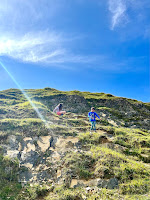Stories round the camp fire.
This could be a real camp fire or a pretend one like the one Honey made at our local nature reserve recently.
The stories could be ones you make up on the spot, you could take a favourite/outdoor themed book with you, or you could bring a story they’ve written as part of their home learning. As you read, stop and ask questions about the story and relate it to what you can see or hear around you. Which trees are wide enough for Max to hide behind? Can you spot anywhere that would be perfect for the wild things to take shelter if it rains? Stories are amazing, they can take you in so many different directions after you’ve finished reading them. Next you could...
Build a den
There are some super science links surrounding which materials to use, asking children to think about how they could make their den waterproof or give it a more comfortable floor for the wild things to lie on.
You could also discuss different types of home at this point, do they know what flats are, what makes a bungalow special? Do they know that some people live in homes that can move, like caravans or narrow boats? From here they could...
Make a nature picture
Ask the children to use whatever they can find in the woods/on your walk, to make a picture of their home or themselves. Talk about the size and shape of the materials that could be used for each section. Do they need to find sticks that are longer than the ones they have? Can they find sticks of an equal length to make a house roof? Can they find a nut or stone that’s a sphere shape to make their eyes? While they’re thinking about themselves, why not...
Have fun with some role play
Perhaps you’ve got a wannabe vet in the family, or a little person who aspires to be a mechanic. Their den could become a surgery or garage. Little ones usually come up with amazing ideas for role play, much better than my ideas, but you could suggest that they find things in the woods that will help them do their job (this usually involves a great big collection of sticks, which can act as tools/instruments). Ace’s favourite is when we draw a racetrack on the woodland floor (move leaves out of the way with your wellies) and then commentate as he races around the track, zooming under bridges (tree branches) and making pit stops for more fuel or spare tyres.
Secret English and secret maths
Use sticks and stones as a substitute for base ten and practise counting in tens or make up addition and subtraction stories together (eg I had 3 sweets and Mummy gave me 2 more, how many do I have now?)
It’s ok not to know all the answers
What’s this flower called Mummy? Is that a beech tree Daddy? Being outside in nature invites A LOT of questions and as much as I love being outdoors, I have no idea what things are most of the time! We now keep a set of I spy books in our adventure bag, so we can look up trees, plants and cloud formations where ever we are. There’s also a wealth of spotting sheets and outdoor resources on The Wildlife Trusts website and the RSPB site too. Lots of their resources are printable, so you take take them with you, or just take a screenshot with your phone if you don’t fancy carrying bits of paper around with you. Failing all of that, ask them to take a photo or draw a sketch so you can look it up (or Facetime Grandad) when you get home!
With the countdown on for the children to be back in the classroom, we will be taking every opportunity we can to explore the world around us and watch the seasons change. If you’re lucky enough to have a toddler or preschooler, all of these activities can be adapted to their level and used any time you’re out and about.
Have fun and please tag me on Instagram (@stephloveshoney) if you try any of these ideas!










No comments:
Post a Comment